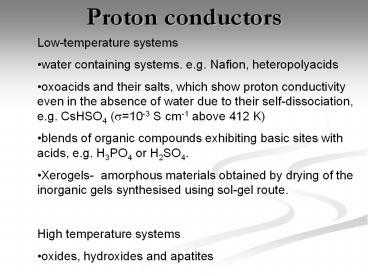Proton conductors - PowerPoint PPT Presentation
Title:
Proton conductors
Description:
Proton conductors Low-temperature systems water containing systems. e.g. Nafion, heteropolyacids oxoacids and their salts, which show proton conductivity even in the ... – PowerPoint PPT presentation
Number of Views:334
Avg rating:3.0/5.0
Title: Proton conductors
1
Proton conductors
- Low-temperature systems
- water containing systems. e.g. Nafion,
heteropolyacids - oxoacids and their salts, which show proton
conductivity even in the absence of water due to
their self-dissociation, e.g. CsHSO4 (s10-3 S
cm-1 above 412 K) - blends of organic compounds exhibiting basic
sites with acids, e.g. H3PO4 or H2SO4. - Xerogels- amorphous materials obtained by drying
of the inorganic gels synthesised using sol-gel
route. - High temperature systems
- oxides, hydroxides and apatites
2
Proton conductivity of some water containing
compounds
The loss of water, which in most cases takes
place at temperatures close to the boiling point
of water, results in a decrease in conductivity
3
Conductivity of high temperature proton conductors
4
Nafion
Heteropolyacid with Keggin structure (e.g.
H3PO4x12WO3)
Poly (2-acrylamido-2-methyl-1-propane sulphonic
acid)
5
Organic-inorganic material, synthesised in
sol-gel process
6
- Polymer electrolytes
- Acidic groups (-COOH, -SO3H) in side or main
chain (part of the polymer bachbone), - e.g. poly (acrylic acid), PAMPS
- Complexes of polymer with salt or acid polymer
with basic sites in a chain is a solvent for the
dopant - Polymer gels- three component systems, combining
polymer matrix swollen with dopant solution in an
an apropriate solvent
Polymers which may be applied in proton
conducting systems should fulfil some
requirements, such as - chemical and
thermodynamic stability - specific protonic
conductivity - conductivity range depending on
the perspective application, i.e. 10-1- 10-3 S
cm-1 for fuel cells and 10-5- 10-7 S cm-1 for
sensors or electrochromic devices - properties
independent of the humidity level - thin film
configuration. The use in electrochromic devices
requires also high transparency of membranes
7
Gel electrolytes Polymers Acrylic and
methacrylic polymers (PMMA, PAN,PGMA,PAAM), poly
(vinylidene fluoride), poly (vinyl chloride),
PEO Solvents Propylene carbonate, ethylene
carbonate, N, N-dimethylformamide, glymes,
N-vinylpyrrolidone Acids Phosphoric acid and
its acidic esters, sulfuric acid, sulphonic
acids, phosphonic acids, heteropolyacids
8
Structure of glycidyl methacrylate and products
of its reaction with phosphoric acid
G.Zukowska, V. Robertson, M. Marcinek, K.R.
Jeffrey, J. R. Stevens J.Phys.Chem. B 10 (2003)
5797
9
Mechanism of proton transport in polymer
electrolytes
Grotthus Fast exchange of protons (hoping)
between neighbouring molecules
Vehicle Transport of a proton as a part of a
bigger species (e.g. anion)
10
DMF-H3PO4 based gels
Protonation of DMF
Proton transport according to Grotthus mechanism
11
PC-H3PO4 based gels
Auto-dissociation of H3PO4 in PC Vehicle
transport at low acid concentration, Grotthus at
high (30-40) concentration
12
Conductivity isotherms for anhydrous proton
conducting gels
? - solvent DMF ? - solvent PC
13
Conductivity of liquid and gel electrolyes based
on PMMA-PC-H3PO4
??? - gels ??? - liquid a)50 mas. H3PO4 b)26
mas. H3PO4 c)19.5 mas. H3PO4
14
Conductivity of liquid and gel electrolytes based
on PGMA-DMF-H3PO4
????? - gels ????? - liquid a)50 mas.
H3PO4 b)44 mas. H3PO4 c)38 mas. H3PO4 d)26
mas. H3PO4 e)8 mas. H3PO4 e)5 mas. H3PO4
GMA (glycidyl methacrylate) reacts with
phosphoric acid with formation of acidic
phosphates (stronger acids than H3PO4) which
results in increase in conductivity
15
NMR measurements of the diffusion of deuterons in
the DMF/phosphoric acid mixtures and in the
PGMA/DMF/H3PO4 gels.
K.R. Jeffrey, G.Z. Zukowska, and J.R. Stevens J.
Chem. Phys. 119 (2003) 2422
The coefficients decrease with acid
concentration and with the introduction of the
polymer gel.
16
A comparison of the diffusion coefficients for
the deuterons and phosphorus in the samples
containing 40 phosphoric acid with and without
the polymer matrix
The measurements were made using the static
magnetic field gradient NMR technique. The
diffusion coefficients for the deuterons are
about a factor of three greater than that for
phosphorus in comparable samples. The influence
of the gel is to reduce the diffusion coefficient.
17
Influence of the type of proton donor on
conductivity in electrolytes based on PMMA-PC-DMF
(a) and PVdF-DMF (b)
?- PWA, ?- diphenyl phosphate, ?- H3PO4
18
Electrochromic device
According to Granqvist
19
Some applications of electrochromic devices
20
Magic ink
21
Modern house































